Enhanced Curriculum Support
This is a comprehensive educational resource designed to provide students with the tools and guidance necessary to excel. This support system is structured to cater to various aspects of learning, ensuring that students are well-prepared for academic challenges and practical applications of mathematical concepts. Some are the key benefits are mentioned below:
1.Comprehensive Learning: This holistic approach helps students gain a thorough understanding of the subject. Practical Application: The resources encourage students to apply mathematical concepts to real-life scenarios, enhancing their practical understanding and problem-solving skills.
2.Critical Thinking and Reasoning: Value-Based and HOTS questions promote critical thinking and reasoning abilities. These skills are crucial for students to tackle complex problems and make informed decisions.
3.Exam Preparedness: Sample Question Papers and NCERT Exemplar Solutions provide ample practice for exams. They help students familiarize themselves with the exam format and types of questions, reducing exam anxiety.
4.Ethical and Moral Development: Value-Based Questions integrate ethical and moral lessons into the learning process, helping in the overall development of students' character and social responsibility. By incorporating these diverse elements, Enhanced Curriculum Support aims to provide a robust and well-rounded knowledge, preparing students for both academic success and real-world challenges.
Sample Question Papers
Sample Question Paper: These are designed to mimic actual exam papers, providing students with a practice platform to gauge their understanding and readiness. They cover a wide range of topics and question types that students might encounter. Regular practice with these papers helps in boosting confidence and improving exam performance.
Quick Points:
Practice for real exam scenarios.
Includes various types of questions.
Helps in time management.
Identifies areas of improvement.
SecA
1.The perimeter of a parallelogram is 150 cm. One of its side is greater than the other by 25 cm. Find length of all sides of the parallelogram.
2.Lengths of adjacent sides of a parallelogram is 3 cm and 4 cm. Find its perimeter.
3.In the given figure PR is a diagonal of the parallelogram PQRS.
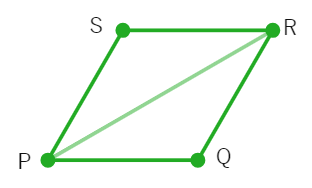
(i) Is PS = RQ? Why?
(ii) Is SR = PQ? Why?
(iii) Is PR = RP? Why?
(iv) Is ΔPSR ≌ ΔRQP? Why?
Sol
1.Solution: Let a and b be the lengths of the sides.
Given that one side is greater than the other by 25 cm, we have a=b+25.
The perimeter of a parallelogram is given by the formula: Perimeter=2(a+b)
We are given that the perimeter is 150 cm. Substituting the values we have: 2(a+b) = 150
2((b+25)+b) = 150 ⇒ 2(2b+25) = 150 ⇒ 4b + 50 = 150 ⇒ 4b = 100 ⇒ b =
Thus, a = b + 25 = 50
Therefore, the sides of the parallelogram are 25 cm and 50 cm.
2.Solution: Let's denote one adjacent side as a=3 cm.
The other adjacent side will be b=4 cm.
The perimeter P of a parallelogram is calculated using the formula: P = 2×(a+b)
P = 2×(3+4)
P = 2×7
P = 14
Therefore, the perimeter of the parallelogram is 14 cm.
3.Solution:
(i) Yes, PS = RQ. In a parallelogram, opposite sides are equal in length. Hence, PS and RQ being opposite sides are equal.
(ii) Yes, SR = PQ. In a parallelogram, opposite sides are equal in length. Hence, SR and PQ being opposite sides are equal.
(iii) Yes, PR = RP. The notation PR and RP represent the same line segment. The equality PR = RP is simply stating that the length of the line segment from P to R is the same as the length of the line segment from R to P, which is always true because they are the same segment.
(iv) In a parallelogram, the diagonals bisect each other. This means that the two triangles formed by one of the diagonals are congruent.
(a) PS and RQ are equal because they are opposite sides of the parallelogram.
(b) SR and PQ are equal because they are opposite sides of the parallelogram.
(c) PR is common to both ΔPSR and ΔRQP.
By the Side-Side-Side (SSS) congruence criterion: ΔPSR ≅ ΔRQP.
SecB
1.One angle of a parallelogram is of measure 70°. Find the measures of the remaining angles of the parallelogram.
2.The adjacent figure HOPE is a parallelogram. Find the angle measure x, y and z. State the properties you use to find them.
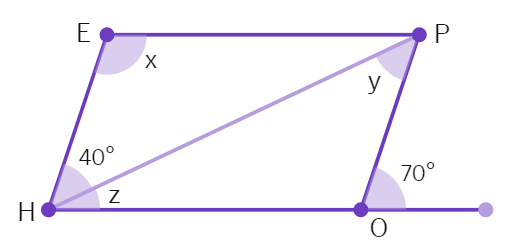
3.Find value of x and y in the following figures.
(i) where ABCD is a parallelogram.
(ii) where PQRS is a rhombus.

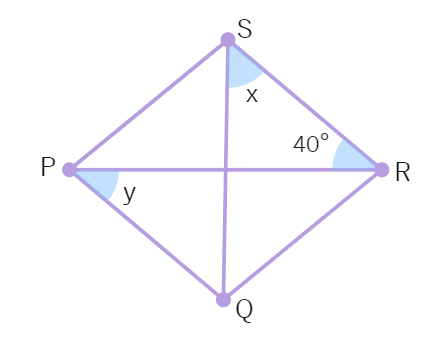
Sol
1.Solution: In a parallelogram, opposite angles are equal, and adjacent angles are supplementary (their sum is 180°).
Given that one angle of the parallelogram is 70°, let's determine the measures of the remaining angles.
Opposite angle: Since opposite angles in a parallelogram are equal, the angle opposite to the given 70° angle is also 70°.
Adjacent angles: Adjacent angles in a parallelogram are supplementary. Therefore, the angle adjacent to the 70° angle can be found by subtracting 70° from 180°: 180° − 70° = 110°
Therefore, the measures of the angles in the parallelogram are: two angles of 70°, two angles of 110°.
2.Solution: From the figure, we know that y = 40° as ∠EPH = ∠OPH (alternate interior angles are equal)
In ΔPHO, we have:
Exterior angle = ∠y + ∠z = 70°
⇒ ∠z = 70° - 40° = 30° ⇒ ∠z = 30°
In ΔPHO, sum of angles is 180° ⇒ ∠POH + ∠y + ∠z = 180° and ∠POH and ∠x are opposite angles of the parallelogram i.e. they are both equal. Thus,
∠x + ∠y + ∠z = 180° ⇒ ∠x + 40° + 30° = 180° ⇒ ∠x + 70° = 180° ⇒ ∠x = 110°
The values of ∠x , ∠y and ∠z are 110°, 40° and 30°, respectively.
3.Solution:
(i) Since, the diagonals in a parallelogram bisect each other:
5y + 1 = 6y - 1 ⇒ 1 + 1 = 6y - 5y ⇒ y = 2
3x - 1 = 2(x + 1) ⇒ 3x - 1 = 2x + 2 ⇒ 3x - 2x = 1 + 2 ⇒ x = 3
(ii) Since, the diagonals of a rhombus bisect each other perpendicularly:
In the triangle formed by the points S and R along with the intersection point of the diagonals, we get: 90° + 40° + ∠x = 180° ⇒ 130° + ∠x = 180° ⇒ ∠x = 50°
Meanwhile, ∠y = 40° as it is an interior angle alternate with the given 40° angle.
SecC
1.In a parallelogram, the ratio of the adjacent sides is 4 : 5 and its perimeter is 72 cm then, find the sides of the parallelogram.
Sol
1.Solution: Let's denote the lengths of the adjacent sides of the parallelogram as 4x and 5x, where x is a common factor.
The perimeter of the parallelogram is given as 72 cm. The perimeter of a parallelogram is calculated as: Perimeter = 2(length+width)
Substituting the given lengths: 2(4x+5x) = 72 ⇒ 2(9x) = 72 ⇒ 18x = 72 ⇒ x = 4
Now, we can find the lengths of the sides:
4x = 4×4 = 16cm and 5x = 5×4 = 20cm
Therefore, the lengths of the sides of the parallelogram are: 16 cm and 20 cm.
Value Based Questions
Value-Based Questions: They integrate moral and ethical values into the learning process, encouraging students to think beyond just academic knowledge. These questions aim to develop a student's character and social responsibility through mathematics. They connect mathematical concepts with everyday life and moral lessons.
Quick Points:
Promotes critical thinking.
Encourages ethical reasoning.
Relates mathematics to real-life scenarios.
Enhances decision-making skills.
Problem 1
An artist is creating a piece of art using different quadrilaterals. She uses a rhombus with each side measuring 5 cm and a height of 4 cm. What is the area of the rhombus? How do artists use mathematical shapes in their creations?
Sol
Solution:
Calculating the Area of the Rhombus:
A = base × height
In this case, the base of the rhombus is the length of its side, which is 5 cm, and the height is given as 4 cm.
So, the area A = 5cm × 4cm = 20
Therefore, the area of the rhombus is 20
Artists use mathematical shapes like rhombuses in their creations to achieve symmetry, create patterns, maintain proportion, add depth, and convey symbolic meanings.
Problem 2
A school is planning to plant trees around a quadrilateral-shaped park. The park is in the shape of a trapezium with the lengths of the parallel sides being 50 meters and 30 meters, and the distance between the parallel sides being 20 meters. How can planting trees around such parks help in maintaining the environment?
Sol
Solution:
The formula for the area 𝐴 of a trapezium is:
A =
Given:
The lengths of the parallel sides are 50 meters and 30 meters.
The distance between the parallel sides is 20 meters.
A =
A =
A = 40 × 20
A = 800 square meters
Therefore, the area of the trapezium-shaped park is 800 square meters.
Planting trees around the park can significantly benefit the environment by improving air quality, regulating temperatures, increasing biodiversity, reducing noise pollution, managing water, enhancing aesthetic and recreational value, and providing educational opportunities.
Problem 3
Riya wants to decorate her rectangular garden with a fence. The length of her garden is 12 meters and the width is 8 meters. How much fencing material does she need to buy to cover the perimeter of the garden? How can knowing the properties of a rectangle help her in real life?
Sol
Solution:
The perimeter P of a rectangle is given by the formula:
P = 2 ×(Length + Width)
Given:
Length l = 12 meters
Width w = 8 meters
P = 2×(12+8) = 2×20 = 40 meters
Therefore, Riya needs to buy 40 meters of fencing material.
Knowing the properties of a rectangle helps in various real-life applications such as accurate planning, space management, home improvement, gardening, construction, and event planning. This knowledge ensures efficient use of resources, better design, and effective project execution.
HOTS
HOTS (Higher Order Thinking Skills): They require students to apply, analyze, synthesize, and evaluate information rather than just recall facts. These questions are designed to challenge students and stimulate intellectual growth. Engaging with HOTS questions helps students to develop a deeper understanding and prepares them for complex problem-solving.
Quick Points:
Develops advanced problem-solving skills.
Encourages deep understanding.
Fosters creativity and innovation.
Enhances analytical abilities.
Q1
1..The diagonal of a rectangle is thrice its smaller side. Find the ratio of its sides
Sol
Solution:
Let's denote:
The length of the rectangle by l
The width of the rectangle by w
Given that the diagonal is thrice the smaller side, let's assume without loss of generality that the width ( w) is the smaller side. Therefore, the diagonal is 3w.
By the Pythagorean theorem for a rectangle, we have:
l =
We get, 𝑙:𝑤 =
Hence, the ratio of the sides of the rectangle is
Q2
2.A polygon has n sides. Two of its angles are right angles and each of the remaining angles is 144°. Find the value of n.
Sol
Solution:
Let's denote:
The sum of the interior angles of the polygon by S.
The number of sides of the polygon by n.
The formula for the sum of the interior angles of an n-sided polygon is: 𝑆 = (𝑛−2) × 180°
Given:
Two of the angles are right angles, so each is 90°
The remaining (n−2) angles are each 144°.
Therefore, the sum of all the interior angles can also be written as: 2×90° +(𝑛−2)× 144°
Equating the two expressions for the sum of the interior angles: 2×90° + (𝑛−2) × 144° = (n−2) × 180°
180° + 144°(n-2) = 180°(n-2)
180° = 36°(n-2)
(n-2) =
n = 5 + 2 = 7
Thus, the polygon has 7 sides.
Q3
3.In an equiangular polygon, the measure of each exterior angle is 25% of the measure of each interior angle. Find the number of sides.
Sol
Solution:
Let's denote:
The measure of each exterior angle by 𝐸.
The measure of each interior angle by 𝐼.
Given: E = 0.25×I
We know that the exterior angle E and the interior angle I of a polygon are related by: E + I = 180°
0.25I + I = 180°
1.25I = 180°
I =
Which gives us: E = 0.25I = 0.25 × 144° = 36°
In a polygon, the sum of the exterior angles is always 360°, and each exterior angle is 𝐸.
Thus, n =
NCERT Exemplar Solutions
NCERT Exemplar Solutions: They provide detailed answers and explanations to problems in NCERT textbooks, aiding students in understanding complex concepts. These solutions serve as a valuable resource for clarifying doubts and reinforcing learning. They are essential for thorough exam preparation and achieving academic excellence.
Quick Points:
Comprehensive solutions for NCERT problems.
Clarifies difficult concepts.
Useful for exam preparation.
Provides step-by-step explanations.
Select the correct option
Questions
1.The number of diagonals in a polygon of n sides is:
(a)
(b)
(c)
(d)
2.The angles of a quadrilateral ABCD taken in an order are in the ratio 3 : 7 : 6 : 4. Then ABCD is a:
(a) kite
(b) parallelogram
(c) rhombus
(d) trapezium
3.In a square ABCD, the diagonals meet at point O. The ∆AOB is:
(a) isosceles right triangle
(b) equilateral triangle
(c) isosceles triangle but not right triangle
(d) scalene right triangle.
4.If the diagonals of a quadrilateral bisect each other at right angles, it will be a:
(a) rhombus
(b) trapezium
(c) rectangle
(d) kite
Sol
1.Solution: Option (c)
2.Solution: Option (d)
3.Solution: Option (a)
4.Solution: Option (a)
Questions
5.The sides AB and CD of a quadrilateral ABCD are extended to points P and Q respectively. Is ∠ADQ + ∠CBP = ∠A + ∠C? Give reason.
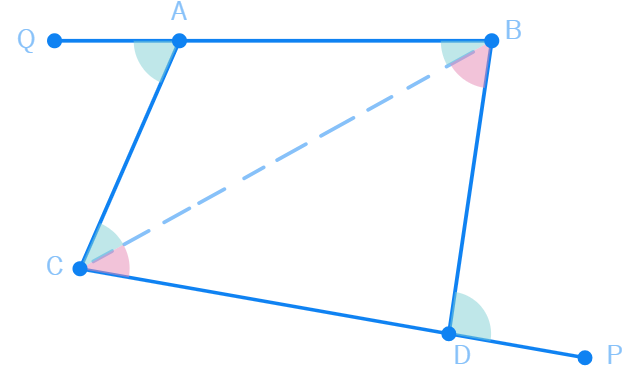
6.The four angles of a quadrilateral are in the ratio 3 : 4 : 5 : 6. Find the angles.
7.In a parallelogram PQRS, the bisectors of ∠P and ∠Q meet at O. Find ∠POQ.
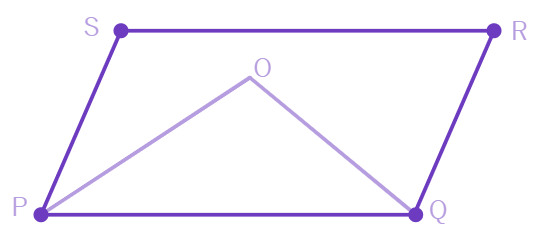
8.If AM and CN are perpendiculars on the diagonal BD of a parallelogram ABCD, Is ∆AMD ≅ ∆CNB? Give reason.
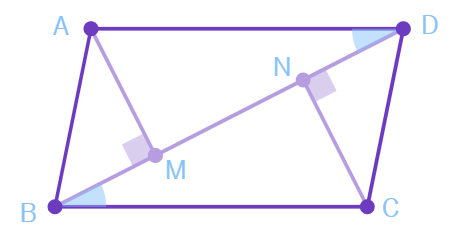
9.Find x in the following figure.

10.The ratio of exterior angle to interior angle of a regular polygon is 1:4. Find the number of sides of the polygon.
Sol
5.Solution:
Join AC.
We get,
∠CBP = ∠BCA + ∠BAC and ∠ADQ = ∠ACD + ∠DAC (Exterior angles of triangles)
Therefore,
∠CBP + ∠ADQ = ∠BCA + ∠BAC + ∠ACD + ∠DAC
= (∠BCA + ∠ACD) + (∠BAC + ∠DAC)
= ∠C + ∠A
Thus, the statement is true
6.Solution:
Let angles be 3x, 4x, 5x, 6x.
Thus, 3x + 4x + 5x + 6x = 360° since sum of the angles of a quadrilateral is 360°.
So, 18x = 360°
or, x = 20°
Thus, angles are 60°, 80°, 100°, 120°.
7.Solution:
Since OP and OQ are the bisectors of ∠P and ∠Q respectively,
so, ∠OPQ =
In ∆POQ,
∠OPQ + ∠PQO + ∠POQ = 180° (Angle sum property)
∠POQ = 180° –
= 180° –
∠POQ = 90°
8.Solution:
In triangles AMD and CNB,
AD = BC (opposite sides of parallelogram)
∠AMB = ∠CNB = 90°
∠ADM = ∠NBC (AD || BC and BD is transversal.)
So, ∆AMD ≅ ∆CNB (by AAS congruency rule)
9.Solution:
In the given figure ∠1 + 90° = 180° (linear pair)
Thus, ∠1 = 90°
Now, since sum of exterior angles of a polygon is 360°,
x + 60° + 90° + 90° + 40° = 360°
x + 280° = 360°
x = 80°
10.Solution:
Let the exterior angle of the polygon be x. Then, the interior angle of polygon = 180° – x
According to question,
4x = 180° – x
5x = 180°
x =
x = 36°
Number of sides of polygon =
=
Thus, Number of sides of polygon = 10
Case Based Questions
Case-Based Question: They present real-life situations requiring students to apply their mathematical knowledge to solve problems, promoting practical understanding. These questions enhance the ability to connect theoretical knowledge with practical applications. They are instrumental in developing problem-solving skills relevant to real-world scenarios.
Quick Points:
Real-life application of concepts.
Encourages analytical thinking.
Enhances comprehension of practical problems.
Promotes interdisciplinary learning.
Q1
A snowflake is formed when water molecules join together to make a rigid shape. The water molecules combine more molecules, they extend and form a rigid crystalline structure i.e., hexagon shape. Sometimes we can see snowflakes with 12 sides, when two snowflakes grow together.

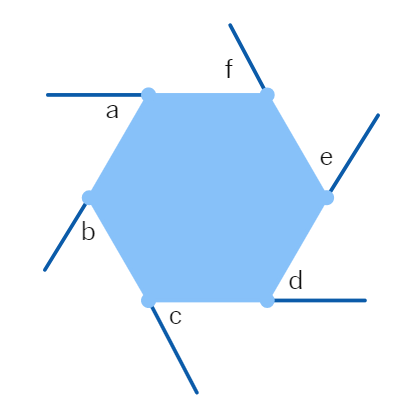
Consider a regular hexagon and answer the following questions:
(i) What is the sum of measure of its exterior angles a, b, c, d, e, f ?
(ii) Is a = b = c = d = e = f? Why?
(OR)
What is the measure of each:
(i) Exterior angle
(ii) Interior angle
(iii) Is a rectangle a regular polygon? Why?
Sol
Solution:
The sum of the exterior angles of any polygon is always 360°, regardless of the number of sides. This is a fundamental property of polygons.
Therefore, the sum of the measures of the exterior angles a,b,c,d,e,f of the regular hexagon is:
a + b + c + d + e + f = 360°
Equality of the Exterior Angles:
In a regular hexagon, all sides and all angles are equal by definition. This applies to both interior and exterior angles.
Since a regular hexagon is symmetric and all its exterior angles are equal, we have:
a = b = c = d = e = f
The sum of the exterior angles of a hexagon is 360°
Given that there are 6 exterior angles in a hexagon, each angle can be calculated by dividing the total sum by the number of angles:
Measure of each exterior angle =
Therefore, each exterior angle a,b,c,d,e,f is 60°, and they are all equal.
(OR)
Measure of Each Exterior Angle:
For any regular polygon, the measure of each exterior angle can be calculated using the formula:
Measure of each exterior angle =
where n is the number of sides.
For a regular hexagon (n = 6):
Measure of each exterior angle =
Measure of Each Interior Angle:
The measure of each interior angle of a regular polygon can be calculated using the formula:
Measure of each interior angle = 180° − Measure of each exterior angle
Given that the measure of each exterior angle of a regular hexagon is 60°
Measure of each interior angle = 180° − 60° = 120°
A regular polygon is defined as a polygon with all sides of equal length and all interior angles of equal measure.
A rectangle has all interior angles equal to 90°. However, not all sides of a rectangle are equal; it has opposite sides that are equal. Therefore, a rectangle is not a regular polygon because, despite having equal interior angles, its sides are not all of equal length.
Q2

Football
1.Identify polygon made on the football
2.What is the measure of each interior angle of this polygon?
3.What is the measure of each exterior angle of the polygon?
Sol
Solution:
1.Hexagon
2.120°
3.60°
